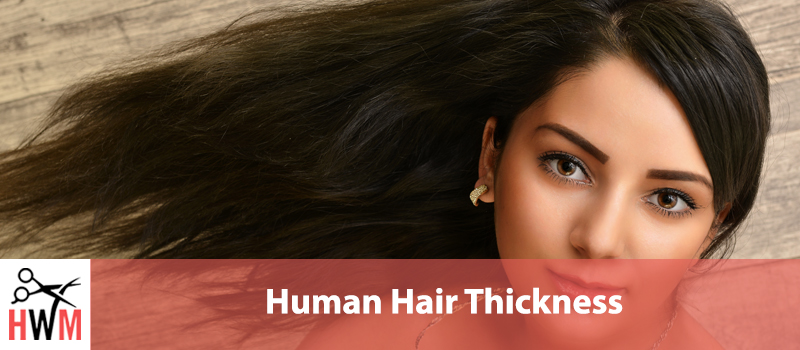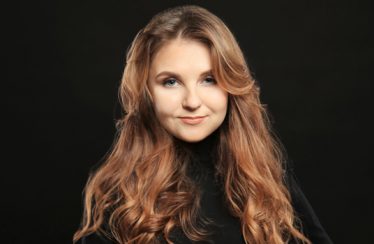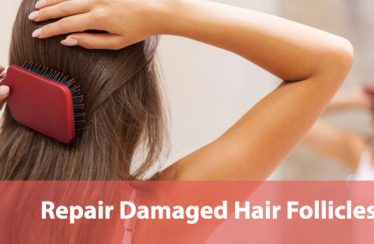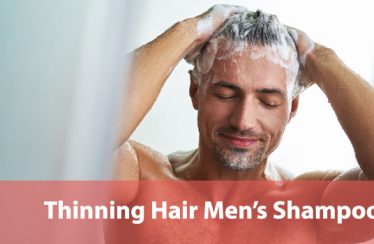If you’re looking to delve into the thickness of human hair, then it is likely that you’re trying to solve some hair-related problems. In fact, you’ve reasoned that you need to learn as much about hair as possible to deal with the problem, with the thickness of hair being the first item on the agenda.
You’re on the right track, of course, because learning about the thickness of human hair will give you a solid grounding in the basics of hair. Moreover, by understanding your hair better, you’ll be better able to take care of it.
You’re on the right track for another reason too. This is the fact that there are a lot of misconceptions about hair circulating amongst the people. Many of these misconceptions and myths can lead to mistakes that will damage your hair even further.
Only by knowing more about your hair will you be able to see through these misconceptions and avoid mistakes. With this primer on the thickness of human hair, we wish to help you in your quest for knowledge. Here is everything you’ll learn on this page.
- What Thickness of Human Hair Is and What It Is Not
- Scientifically, What Is the Thickness of Hair?
- Does the Thickness of Hair Vary?
- Which Factors Determine the Thickness of Human Hair?
- How Hair Composition Affects its Thickness
- How Can the Thickness of Human Hair Be Measured?
- What Can You Do to Increase the Thickness of Your Hair?
What Thickness of Human Hair Is and What It Is Not
The fact that people see thick hair as the opposite of thin hair is the most common misconception related to the thickness of hair. You see, the opposite of thick hair is fine hair instead of thin hair, while the closest opposite of thinning hair would be voluminous hair.
The thickness of human hair pertains to the diameter of the hair while thinning hair refers to the gradual decrease in the number of hair strands on the scalp. In other words, thinning hair is about hair density rather than the width of individual hair strands.
Both thick hair and voluminous hair can be seen as markers of hair health. For instance, healthier hair tends to be thicker in diameter than hair that is not healthy. Similarly, healthier people tend to have more hair strands or more voluminous hair than people dealing with major deficiencies or illnesses.
The volume of hair on your scalp and the thickness of individual strands are both susceptible to aging as well. For example, someone coping with androgenetic alopecia or even alopecia areata will first see his hair strands become thinner and weaker before they break or fall off.
Scientifically, What Is the Thickness of Hair?
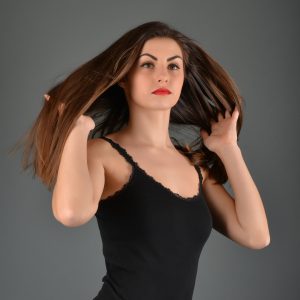
Scientifically speaking, the human hair measures approximately 75 microns on average. A micron is also known as a micrometer. It is equivalent to about a millionth of a meter. In terms of inches, 75 microns amount to approximately 0.003 inches.
In case you’re having trouble imagining such small sizes, here are some comparisons.
- The human red blood cell measures approximately 5 microns across or approximately 0.0002 inches.
- A bacterium can measure anything between 0.2 microns to 3 microns. This amounts to an approximate range of 7.874e-6 (call it unfathomable) and 0.0001 inches.
- A generic sheet of paper would measure approximately 100 microns or 0.004 inches.
- A grain of sand measures around 1250 microns, which amounts to around 0.05 inches.
- A strand of spaghetti measures about 1700 microns in width, which is the same as 0.067 inches.
Does the Thickness of Hair Vary?
The thickness of the hair is always cited as an approximate or average value. There’s a simple reason for this, i.e. the thickness of hair varies. It varies not only from one person to another but also from one strand to another. Your hair strands could measure anything between 0.002 inches to 0.005 inches, depending on a wide variety of variables.
For example, if you pluck out a hair from your head and one from your leg or arm, you’ll find that they have different measurements. In fact, even if you pluck a hair strand from the crown of your head and one from the fringes, you’re likely to see variation.
This variation extends to time too. The thickness of one hair strand will vary according to when you measure it. For instance, your hair will be thicker in younger years and finer later. Similarly, if you measure your hair in a very humid environment, you’ll find it to be thicker than if you were to measure it in arid environments.
Your genetic heritage will impact the thickness of your hair also. Generally speaking,Asians tend to have the thickest hair, i.e. the maximum width of a hair, while Caucasians tend to have the finest hair i.e., the slimmest. Africans fall somewhere in the middle in terms of thickness of hair, but they don’t have the same density as other ethnic groups.
Furthermore, darker colored hair is usually thicker than lighter colored hair. As a result, jet black hair is the thickest of all, while blonde hair is the thinnest. This is partly because of the presence or absence of hair pigment, something that we’ll explore later on this page.
Which Factors Determine the Thickness of Human Hair?
The thickness of human hair varies in terms of person, location, and situation because multiple variables influence it.
Specifically, the thickness of your hair is a derivation of your parents, your location, and your daily habits. In other words, genetics, environmental conditions, and general health determine the thickness of your hair. Let’s explore each one a little more.
Genetics
The absolute foundation of the thickness of your hair is your genetic profile. If your parents and extended family have a certain type of hair, then it is likely that you have the same type of hair also. Moreover, you can expect your kids to have the same hair type as well.
However, instead of calling it a foregone conclusion, it is better to see it as a genetic predisposition. In other words, your genetic history is most likely to determine the thickness of your hair, but the final result isn’t set in stone. It just means that it is highly probable.
This isn’t unlike what happens with androgenetic alopecia or pattern baldness. Both these hair loss problems are genetically handed down from parents to children. However, there are lots of exceptions as well.
For example, instances of pattern baldness skipping one generation are fairly common. Furthermore, there is even some evidence that the maternal branch of the family has more of a say on the nature of an individual’s hair than the paternal side.
All this is relevant to the thickness of human hair too. Therefore, if your father’s side has finer hair and your mother’s side thicker hair, then you’re more likely to have thicker hair, but you can still get fine hair while your child gets thick hair.
Health
The influence of genes only creates a strong predisposition towards a certain thickness and type of hair. It accounts for the “nature” element in the nature vs. nurture debate. However, as most trichologists and scientists will tell you, “nurture” has an equal role to play in the development of specific traits.
In the case of the thickness of an individual’s hair, this means overall and current health. A person who has led a healthy, active life with the best nutrition possible since childhood will have healthier hair than one who hasn’t. As we’ve already explained above, healthy hair means thicker hair in terms of both individual strands and volume.
The current state of an individual’s health will also affect the thickness of their hair. The best proof of this is people going through chemotherapy. While most people know that chemotherapy causes hair loss, many don’t realize that it causes the hair to become finer first. In fact, while the hair grows back once chemotherapy stops, it is often finer and patchier than what the person had before.
Another example of how current health can affect the thickness of the hair is pregnancy. The vast majority of a pregnant woman’s bodily resources are used towards developing the fetus she is carrying. This often means that other aspects and systems of the body drop down the body’s priority list. One of these aspects is hair thickness and health.
In fact, pregnant women are advised by their doctors to expect a marked increase in hair loss and thickness precisely for this reason. Further, most doctors prescribe vitamins such as folic acid to pregnant women to help against deficiency-related problems like hair loss.
Environmental Conditions
Environmental conditions can also impact the thickness of human hair. The fact that the majority of Scandinavians are either blonde or red-headed (finer than darker hair) proves this basic fact. Their hair is either blonde or red, and their skin pale because it allows them to absorb as much sunlight as possible.
Darker hair and skin tone, as you may already know, is a result of the pigment melanin. Melanin in hair and skin can block the sun’s rays and is usually seen in people of countries and regions that receive a lot of sunlight.
The fact that Africans almost always have thick, black hair and skin tone can be seen as the opposite of the Scandinavian scenario. Changes in the melanin content in the hair and skin in large groups of people, however, will take decades to come into effect if not generations.
A more direct and pertinent proof of how environmental conditions affect the thickness of the hair is prolonged exposure to the sun. When thick, dark hair is overexposed to the sun, its melanin content gets destroyed, causing it to not only become bleached but also straw-like i.e. very fine.
Chemicals and excess heat can also affect the thickness of human hair. To see if this is true, all you need to do is ask any woman who styles her hair regularly. Chemical treatments and hairdryers both will make the hair finer when they’re overused.
How Hair Composition Affects its Thickness
Broadly speaking, hair is composed of protein, water, and pigments. Of these, protein accounts for 80 percent of the hair, water ten to 15 percent, and pigments five to ten percent.
The protein component of hair is dependent on the general health of the individual. It is this component that is most affected by poor nutrition and other health concerns.
The water component of hair is possibly the most transient because it is affected by both the general health of the individual and the surrounding environment. Variation in the water content of the hair is why its state changes between humid and arid environments.
The varying pigment content of hair is the main reason why people from varying locations around the globe have different thicknesses of hair.
How Can the Thickness of Human Hair Be Measured?
Till now, we’ve only spoken about the thickness of hair in general terms in this guide. What if you were interested in specifics? In other words, what if you wanted to pinpoint the thickness of your hair?
There’s no practical reason for you to want this, but sometimes scientific curiosity or the need to win a bet is very hard to resist. Whatever may be your reason, we’ll help you attain your goal.
There are mainly three ways of measuring the thickness of human hair – the grip technique, the thread technique, and the laser technique.
The Grip Technique
This is the easiest but the least accurate technique. The reason for this is that this technique won’t give you results in numbers. Instead, you’ll only get a rough idea about the thickness of your hair.
Even so, this technique is still ideal for people looking to figure out if they have fine hair or thick hair. As a result, it is particularly beneficial and convenient for people who have just started realizing that hair products are designed for different types of hair.
The technique is simplicity itself. All you need to do is pluck a hair strand and roll it between your thumb and index finger. Your results will depend on whether you can feel the hair strand or not.
The Thread Technique
Another simple method of measuring the approximate thickness of your hair is to compare it to a thread. The process is, again simple. You need to pluck out a hair strand, ensure that it is clean of hair products, and place it on a sheet of paper. Now, stretch a thread next to it and visually compare the two.
For most of you, the hair strand will be thinner than the thread. If it isn’t, then you have very thick hair. If it is, then you can decide whether it is of normal thickness or very fine based on how thinner it is compared to the thread in question.
If you know the thickness of the thread (some sellers specify it on the label), then you can get an approximate number. For instance, if you think your hair strand is about 50 percent of the thread, then some basic calculations will give you your results.
The Laser Technique
The most accurate method of measuring the thickness of your hair is the laser technique. This technique, though, is also the most calculation heavy. So, get ready for some arithmetic.
In this technique, you use a laser pointer on a hair in a way that the light diffracts onto a wall or screen. The best way is to stick the hair on a cardboard frame with a rectangular hole in the middle. You set this cardboard on a surface and aim the laser onto the hair in a way that the light diffracts onto the screen.
After this, it is all about measuring and calculating things. You’ll need to measure parts of the diffracted light on the wall as well as the distance between the screen and the hair. You’ll also need the wavelength of the light, which should be printed on the laser device.
Putting these values in a formula will give you the thickness of your hair. You can use this video to get the formula as well as more detailed instructions on the laser technique.
What Can You Do to Increase the Thickness of Your Hair?
Let’s get one thing out of the way. You cannot change the texture of your hair overnight. You cannot change your genetics and years of poor nutrition or environmental exposure.
What you can do, however, is gradually nurture your hair to its healthiest possible state. Since healthy hair is always thicker than unhealthy hair, this will increase the thickness of your hair.
Of course, you can always use hair products designed to make your hair look thicker and more voluminous, but those improvements are purely cosmetic. Those products will not increase the thickness of your hair. Instead, they’ll just make your hair “look” thicker.
Coming back to actually increasing the thickness of your hair, here are some techniques and improvements you can try.
Ensure Proper Nutrition
If you could do only one thing to increase the thickness of your hair, we would advise you to focus on nutrition. All other tips and tricks to increase the thickness of hair are secondary to this basic requirement.
After all, if you don’t give your body enough protein or micro nutrients, then it will not be able to grow healthy, thick, and luxurious hair. As to what nutrients you need to focus on most, here is a quick primer.
Proteins
Proteins are the single most important nutrient you should focus on. Proteins are long chains of amino acids. Different types of proteins vary either on the basis of the type of amino acids they contain or how they’ve been combined.
In fact, there are more types of proteins than types of amino acids. This means that the same type of amino acids could be used to make different types of proteins depending upon the configuration in which they’re arranged.
Our bodies break down the proteins we eat into their base amino acids. These amino acids are then repurposed to produce other proteins. One of these proteins is keratin, which accounts for 80 percent of our hair.
In a nutshell, our bodies need proteins to be able to grow thick and healthy hair. These proteins could be sourced from animal-based foods such as eggs and meats or plant-based foods such as soybeans and dairy products.
Omega 3-Fatty Acids
Omega 3-fatty acids are scientifically proven to boost hair growth, which automatically means that they can increase the thickness of your hair too. The biggest problem with omega 3-fatty acids, however, is that they’re not part of most people’s daily diets.
The reason for this is that very few foods contain omega 3-fatty acids. One food group that is rich in omega 3-fatty acids, though, is seafood. Fatty fish such as salmon, mackerel, and herring are particularly good sources of this nutrient.
If you’re looking for omega 3-fatty acids containing foods that are easier to incorporate into your diet than seafood, you should consider eggs and olive oil. Even though these foods don’t contain as much omega 3-fatty acids as seafood, they’re good sources for people living in landlocked, arid regions.
Vitamins
Vitamins are enablers in the human body. Even though we don’t need vitamins in large quantities, we need them in regular doses because they make bodily processes possible.
Moreover, all vitamins are important for healthy hair. If you’re deficient in even a single vitamin, the effects will become visible first in your hair, skin, and nails. While all vitamins are important, some are critical for healthy hair growth and, hence the thickness of hair.
The foremost of these is biotin. Biotin is also known as vitamin H or vitamin B7, which makes it a part of the B-complex vitamins. Biotin is important because it improves the keratin infrastructure in the body i.e. it makes it easier for your body to manufacture keratin.
Another important vitamin for healthy hair is provitamin B5 because it improves the body’s ability to absorb other vitamins. It is also responsible for making your hair more elastic, which can only be achieved with thicker hair.
Minerals
The two most important minerals for healthy hair are iron and zinc.
Iron is essential for the proper functioning of the body’s circulatory system because it is a key component of red blood cells. Since red blood cells are responsible for carrying oxygen to various parts of the body, sufficient iron ensures cellular health all over the body, including the scalp.
Zinc also impacts cellular health because it supports cellular division and development. Since cellular growth is critical for follicular health and proper hair growth, zinc becomes critical to overall hair health and thickness.
Additionally, zinc is also a great inhibitor of dihydrotestosterone or DHT. DHT is primarily responsible for pattern hair loss in men and women. As a result, people suffering from pattern hair loss will find zinc particularly helpful.
A Note on The Quality of The Food You Eat
It isn’t just what you eat, either. It is also about how you eat i.e. how regular you are with your meals and how they’re cooked.
For example, you can have loads of chicken burgers in the name of proteins, but they will not help you that much when compared with a chicken steak grilled at home with the right kind of fats.
Similarly, you cannot have fries in the name of veggies. You need broccoli, peas, carrots, spinach, and other healthy vegetables cooked in the right way to benefit from the micronutrients they contain.
You should also make an effort to balance your meals. This means having sources of carbohydrates, proteins, vitamins, and minerals in every meal. It is also a good idea to incorporate fiber into your diet.
Use Natural Hair Masks or Oils Regularly
While the best way to ensure proper nutrition is to eat the right foods, the nutrients you ingest are used all over your body. This increases the time it takes for dietary changes to show results in hair.
One of the ways of speeding up these results is to give your scalp, hair follicles, and hair direct access to these ingredients. You can do this by using hair masks and oils. The topical application of naturally occurring substances can supplement dietary improvements really well.
Applying oils is the easiest of the two since it requires minimal preparation. You just have to ensure that the oils you use are natural, unadulterated, and as close to their natural source as possible.
Another benefit of using oils is that you’ll have a wide variety of options to choose from, with varying benefits and advantages. You’ll be able to choose from coconut oil, castor oil, almond oil, argan oil, avocado oil, peppermint oil, jojoba oil, lavender oil, olive oil, and lemongrass oil amongst many others.
You can even combine two or more oils for added benefits. It is also worth pointing out that before shampoos and conditioners were developed, people used oils for everything ranging from cleansing the hair to moisturizing it.
Hair masks are also beneficial because they allow you to use raw ingredients on your hair. This means that you get access to the nutrients of those ingredients without any processing in the middle.
However, this is only possible if you make your own hair masks at home. You can use several ingredients to do this too. Ingredients that people commonly use to make hair masks include eggs, oranges, avocado, aloe vera, apple cider vinegar, honey, lemons, and many others.
Avoid Routine Self-Inflicted Hair Damage
Anything that will make your hair and hair follicles weaker will slowly lead to your hair becoming finer. Many things that have become a part of the modern routine, unfortunately, turn out to be harmful to our hair.
The best example of this is how often people wash their hair and the kind of hair products they use. Between the frequency of these washes and the type of products we use, most of us end up stripping our hair of its natural protector – sebum.
Sebum is the technical name of the natural oils produced by our skin and scalp. The loss of sebum exposes our hair to the elements and makes it more susceptible to breakage. This is why, unless you’re blessed with very thick hair, regular washing will cause your hair to become finer gradually.
The best way to avoid this is to reduce how often you wash your hair in a week. About two to three times a week should be sufficient for most people.Additionally, avoiding harsh hair products should also be on your priority list. This includes shampoos and conditioners with sulfates, parabens, silicones, and other similarly damaging ingredients.
You also need to be careful about the buildup. If your hair follicles get buried under buildup, then they’ll have trouble pushing out thicker hair. Therefore, you should not only avoid hair products that are known for causing buildup, but also deep cleanse your scalp once a week.
Avoid Making Damaging Styling Choices
The use of hot tools and chemical treatments will also impact the thickness of the hair.
Hot tools will take away the water content of the hair while simultaneously affecting their structural integrity. Since water accounts for ten to 15 percent of the hair, its loss can affect the thickness of hair considerably.
More importantly, without sufficient moisture, your hair will become more susceptible to damage. This is why, by simply avoiding regular use of hot tools, you can make a huge difference in the thickness of your hair.
Chemical treatments also the moisture content of the hair too. However, these treatments are most damaging because they affect the chemical composition of the hair.
The purpose of these treatments is to break the natural chemical bonds of the hair to change its shape. Since proteins are involved in these bonds, the treatments can end up damaging them too. This is why people who get chemical treatments regularly end up with straw-like lackluster hair.
Contents
- What Thickness of Human Hair Is and What It Is Not
- Scientifically, What Is the Thickness of Hair?
- Does the Thickness of Hair Vary?
- Which Factors Determine the Thickness of Human Hair?
- How Hair Composition Affects its Thickness
- How Can the Thickness of Human Hair Be Measured?
- What Can You Do to Increase the Thickness of Your Hair?
